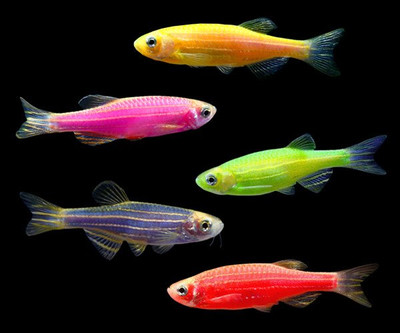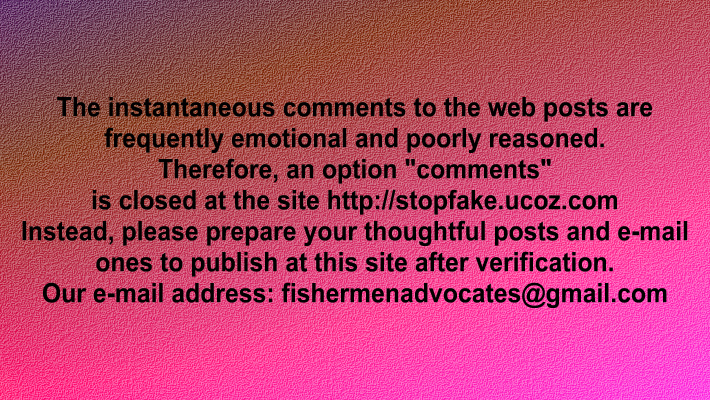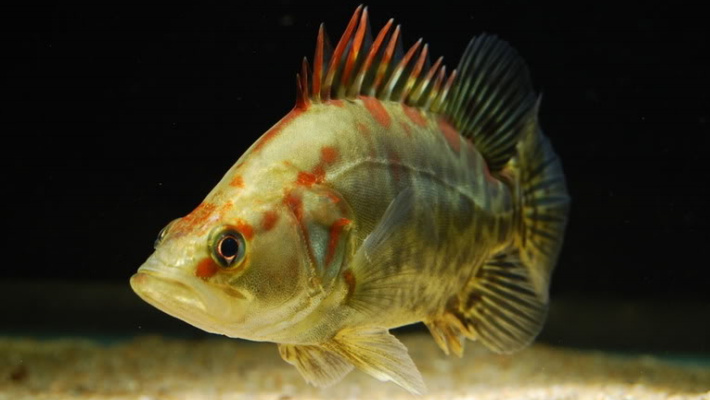Responses of freshwater fish to fluorescent lures at daylight
Many companies manufacture fishing lures and baits of bright fluorescent colors and position these products in the consumer markets as effective tools to attract and catch fish. However, numerous scientific, technical and applied investigations and recreational fishing practice show that these assertions are, as minimum, exaggerated.
In general case, fluorescence is an optical phenomenon when molecules of some substances absorb light in the ultraviolet or visual parts of the electromagnetic spectrum and immediately re-emit it with the longer wavelength. Because the falling light is partly reflected by these substances and the reflected light is mixed with the light of fluorescence, the eyes of human and animals (if they have color vision) perceive the total colors of these substances as “more bright”.
Spectral sensitivity
Fresh waters are optically more turbid than sea waters, so the maximum of spectral sensitivity in freshwater fish is shifted to the red part of the visual spectrum. In bluegill sunfish, Lepomis macrochirus, for example, the maximum of spectral sensitivity is shifted to 620-640 nm (orange part of the spectrum) (Hawryshyn et al., 1988). According to Kawamura & Kishimoto (2002), the maximum of spectral sensitivity in largemouth bass, Micropterus salmoides, is shifted even to 673 nm (red part of the spectrum). It means that for freshwater fish red and orange colors are brighter than other colors, in full contradiction with the perception of saltwater fish and human.
This red or orange shift of the maximum of spectral sensitivity is typical for other freshwater fish (Protasov, 1978).
Turbidity
Turbid waters decrease overall intensity of ambient light, decrease via scattering an ability of receivers to resolve silhouettes and more (for review, see Utne-Palm, 2002). In particular, turbidity affects color perception of freshwater fish, their color patterns and communication with the assistance of color signals.
For example, with an increase in turbidity of habitat males of red shiners, Cyprinella lutrensis, develop more intensive red fins (Dugas & Franssen, 2011). According to Kelley et al. (2012), rainbowfish, Melanotaenia australis, in the dissolved organic matter treatment show an increase in the area and brightness of their orange striped patterns.
More generally, turbidity weakens color signals in inter-sexual selection (Seehausen et al. 1997), even limiting species recognition in mate choice.
Fluorescent colors underwater
Overall, fluorescent colors are brighter than ordinary colors and are more visible underwater (Kinney et al., 1967). In turbid water (like Thames river), orange fluorescent color is most visible for the human’s eye than other colors.
Other animals
For fruit fly, Anastrepha suspensa, traps of orange fluorescent color are more attractive than traps of ordinary orange color (Greany et al., 1978).
Dull males versus bright males
Accustomed to think that females, in fish and other animals with the sexual dimorphism, prefer to mate with bright males than with dull males. In turn, generally recognized that bright males are more vulnerable to predation risks than dull males. However, special and most detailed investigations of these questions reveal that these “generally accepted rules” are not universal.
For example, Breden & Stoner (1987) have shown that females of guppy, Poecilia reticulata, from high-predation populations show genetically determined, lower preference for brightly colored males than do females from areas of low predation. In turn, predatory pike cichlid, Crenicichla alta, prefer to attack in sex-mixed schools of guppy dull and most profitable females than bright and less profitable males (Pocklington & Dill, 1995).
In other words, detection of potential prey even from the longer distance and the real attack on prey need the different decisions making and are separated in time.
Transgenic fluorescent zebrafish
The development of transgenic zebrafish, Danio rerio, and other fish with green, yellow, orange, red and other fluorescent colors has opened an opportunity to study the role of fluorescence in intraspecific and interspecific relations in fish and their predators under the control conditions. Note that under the day light transgenic zebrafish have slightly more intensive colors than wildtype zebrafish (usually with the longitudinal bluish and yellowish stripes), but under the special ultraviolet illumination (invisible for human) they become extremely bright (for example, see photos given by Gong et al., 2003).
In our context, Cortemeglia & Beitinger (2006) have found that under the day light predatory largemouth bass, M. salmodes, consume red fluorescent zebrafish and wildtype zebrafish approximately in an equal proportion. According to Jha (2010), snakehead, Channa striatus, consume under the day conditions both red fluorescent zebrafish and wildtype zebrafish, but try to avoid red fluorescent zebrafish. However, Hill et al. (2011) have found that largemouth bass consume under the day conditions about two times more red fluorescent zebrafish than wildtype zebrafish and concluded that transgenic fish are more susceptible to predation.
In boreal countries (like Ukraine), wildtype and transgenic zebrafish are not survive in the nature due to the cold winters. So, in our experiments we used common perch, Perca fluviatilis, as native predators (about 5-7 cm total length) and aquarium forms of wildtype and red fluorescent zebrafish as popetial prey.
An experimental aquarium was located near the large laboratory windows and was illuminated with the ambient light, which varied from daylight to twilight and nightlight. Because perch were not familiar with both forms of zebrafish, they learnt to hunt novel prey (note, perch are diurnal and crepuscular predators). Briefly, perch passed from the first observations for prey to approaches, chases and the first prey captures (about mutual learning in predators and prey, see Lescheva & Zhuykov, 1989). Under the day and crepuscular illuminations, no preferences of perch towards wildtype or red fluorescent zebrafish (relatively dull under these illuminations) were observed. However, under additional ultraviolet illumination red fluorescent zebrafish became very bright, and perch avoided them (during 3 days of observations none of bright prey were eaten).

Fig. 1. Transgenic fluorescent danios (http://shop.glofish.com/products/glofish-danio-package).
According to our abservations, pike, Esox lucius, another diurnal and crepuscular predator, does not avoid dull red fluorescent zebrafish but avoid bright (UV illuminated) prey.
In the wild nature, visually guided fish may include in their diets new and brightly colored prey but only after long-term testing of these prey and formation of search image in respect to these prey. For example, Hope (1984) has informed that wild trout included in their diet an invasive species of beetles with bright coloration only through about month of acquaintance with this new prey and their testing.
Large fluorescent objects versus small fluorescent implants
It is necessary to distinguish large fluorescent objects and small fluorescent implants used to tag fish. It is shown (e.g., Catalano et al., 2001; Roberts & Kilpatrick, 2004) that small but bright fluorescent implants may attract predators and thus decrease the recapture rate of tagged fish in the nature.
Fluorescent fishing lines
It is shown that largemouth bass may distiguish white, yellow and green fluorescent fishing lines but only after several trials with attached worms to these lines (Miller & Janzow, 1979).
Fishing practice. Part 1
There are fish habitats that allow to confirm the attractiveness of red or orange fluorescent lures at the statistic level. These habitats are rivers with clayish banks, clay pits or clay ponds in which water may be very turbid especially under wind and after rains.
Using one of these localities, we tested soft plastic lures of red fluorescent color and ordinary red color. Lures, namely curly tails of 3 cm length, were rigged in pairs at the distance of 10-12 cm between each other. Fish could observe both lures simultaneuosly for free choice, so the sign test for paired comparisons was used for statistics.
Tests were carried out in summer in clayish locality of Goryn river (Belarus). According to visual guide, turbidity of the water was about 90 NTU (nephelometric turbidity units) and more under wind. Red fluorescent lures were illuminated naturally in the air under the sun light.
During 2 days of experiments, overall 39 fish were caught using standard spinning technique. They were adult perch, P. fluviatilis, and Donets ruffe, Gymnocephalus acerina, as well as juvenile pike, E. lucius, zander, Stizostedion lucioperca, asp, Aspius aspius, and chub, Leuciscus cephalus. Of these 39 fish, 28 fish preferred red fluorescent lures over ordinary red lures (sign test, P < 0.01).
However, in more or less clear waters red or orange fluorescent lures may seem too bright and thus they may deter or scare predatory fish.
It is known that mature males of three-spined sticklebacks, Gasterosteus aculeatus, with the red breast aggresively attack other mature males and artificial wooden red models (Darkov, 1980). According to our observations in the nature, nest guarding males of sticklebacks attack in the same manner approaching soft plastic shads (3 cm length) of ordinary red color but avoid much more conspicuous red fluorescent shads (additionally to sun light illuminated by LED lantern).
Fishing practice. Part 2
Other fish habitats suitable to use red or orange fluorescent lures are river back waters, lakes and ponds in which water is saturated with the soluble organic substances and suspensions (like algae). In these habitats, for example, some natural white maggots with one red fluorescent maggot can be more attractive for carp, Cyprinus carpio, tench, Tinca tinca, and other cyprinids than the same natural white maggots without one very visible red fluorescent maggot. However, preferences of cyprinid fish to red or orange fluorescent lures are not widespread, stable and suitable for statistic confirmations because colors of baits are not prefered stimuli for these fish.
Foraging carps and other large bentivorous fish increase turbidity of water bodies (e.g., Richardson et al., 1995; Roberts et al., 1995; Drenner et al., 1997; Sidorkewicj et al., 1998) thus making these habitats suitable to use red or orange fluorescent lures.
According to Sidorkewicj et al. (1998), tubidity induced by carps may achieve 100-140 NTU.
Note also, turbidity induced by carps decreases angler catch rates of other sport fish (Drenner et al., 1997).
Basic references
Breden F., Stoner G. 1987. Male predation risk determines female preference in the Trinidad guppy. Nature 329, 831-833
Catalano M.J., Chipps S.R., Bouchard M.A., Wahl D.Y. 2001. Evaluation of injectable fluorescent tags for marking centrarchid fishes: Retention rate and effects on vulnerability to predation. North American Journal of Fisheries Management 21, 211-217
Cortemeglia C., Beitinger T.L. 2006. Susceptibility of transgenic and wildtype zebra danios, Danio rerio, to predation. Environmental Biology of Fishes 76, 93-100
Darkov A.A. 1980. Ecological features of visual signalization in fishes. Science Publishing, Moscow
Drenner R.W., Gallo K.L., Edwards C.M., Rieger K.E., Dibble E.D. 1997. Common carp affect turbidity and angler catch rates of largemouth bass in ponds. North American Journal of Fisheries Menagement 17, 1010-1013
Dugas M.B., Franssen N.R. 2011. Nuptial coloration of red shiners (Cyprinella lutrensis) is more intense in turbid habitats. Naturwissenschaften DOI 10.1007/s00114-011-0765-4
Gong Z., Wan H., Tay T.L., Wang H., Chen M., Yan T. 2003. Development of transgenic fish for ornamental and bioreactor by strong expression of fluorescent proteins in the skeletal muscle. Biochemical and Biophysical Research Communications 308, 58–63
Greany P.D., Burditt A.K., Agee H.R., Chambers D.L. 1978. Increasing effectiveness of visual traps for the Caribbean fruit fly, Anastrepha suspensa (Diptera: Tephritidae), by use of fluorescent colors. Entomologia Experimentalis et Applicata 23, 20-25
Hawryshyn C.W., Arnold M.G., McFarland W.N., Loew E.R. 1988. Aspects of color vision in bluegill sunfish (Lepomis macrochirus): ecological and evolutionary relevance. Journal of Comparative Physiology A164, 107-116
Hill J.E., Kapuscinski A.R., Pavlowich T. 2011. Fluorescent transgenic zebra danio more vulnerable to predators than wild-type fish. Transactions of the American Fisheries Society 140, 1001-1005
Hope J. 1984. The well-lured trout. Science 84, 160-167
Jha P. 2010. Comparative study of aggressive behaviour in transgenic and wildtype zebrafish Danio rerio (Hamilton) and the flying barb Esomus danricus (Hamilton), and their susceptibility to predation by the snakehead Channa striatus (Bloch). Italian Journal of Zoology 77, 102-109
Kawamura G., Kishimoto T. 2002. Color vision, accomodation and visual acuity in the largemouth bass. Fisheries Science 68, 1041-1046
Kelley J.L., Phillips B., Cummins G.H., Shand J. 2012. Changes in the visual environment affect colour signal brightness and shoaling behaviour in a freshwater fish. Animal Behaviour 83, 783-791
Kinney J.A.S., Luria S.M., Weitzman D.O. 1967. The visibility of colors underwater. Journal of the Optical Society of America 57, 802-807
Lescheva T.S., Zhuykov A.Y. 1989. Learning in fish. Ecological and applied aspects. Moscow, Science
Miller R.J., Janzow F.T. 1979. An experiment on visual discrimination in the largemouth bass, Micropterus salmoides. Proceedings of the Oklahoma Academy of Science 59, 34-40
Pocklington R., Dill L.M. 1995. Predation on females or males: who pays for bright male traits? Animal Behaviour 49, 1122-1124
Protasov V.R. 1978. Fish behaviour. The mechanisms of fish orientation and their use in fishing. Food Industry Publishing, Moscow
Richardson M.J., Whoriskey F.G., Roy L.H. 1995. Turbidity generation and biological impacts of an exotic fish Carassius auratus, introduced into shallow seasonally anoxic ponds. Journal of Fish Biology 47, 576-585
Roberts J., Chick A., Oswald L., Thompson P. 1995. Effect of carp, Cyprinus carpio L., an exotic benthivorous fish, on aquatic plants and water quality in experimental ponds. Marine and Freshwater Research 46, 1171-1180
Roberts J.H., Kilpatrick J.M. 2004. Predator feeding preferences for a benthic stream fish: effects of visible injected marks. Journal of Freshwater Ecology 19, 531-538
Seehausen O., van Alphen J.J.M., Witte F. 1997. Cichlid fish diversity threatened by eutrophication that curbs sexual selection. Science 277, 1808-1811
Sidorkewicj N.S., López Cazorla A.C., Murphy K.J., Sabbatini M.R., Fernandez O.A., Domaniewski J.C.J. 1998. Interaction of common carp with aquatic weeds in Argentine drainage channels. Journal of Aquatic Plant Management 36, 5-10
Utne-Palm A.C. 2002. Visual feeding of fish in a turbid environment: physical and behavioural aspects. Marine and Freshwater Behaviour and Physiology 35, 111–128
| 







 SUBSCRIBE
SUBSCRIBE



